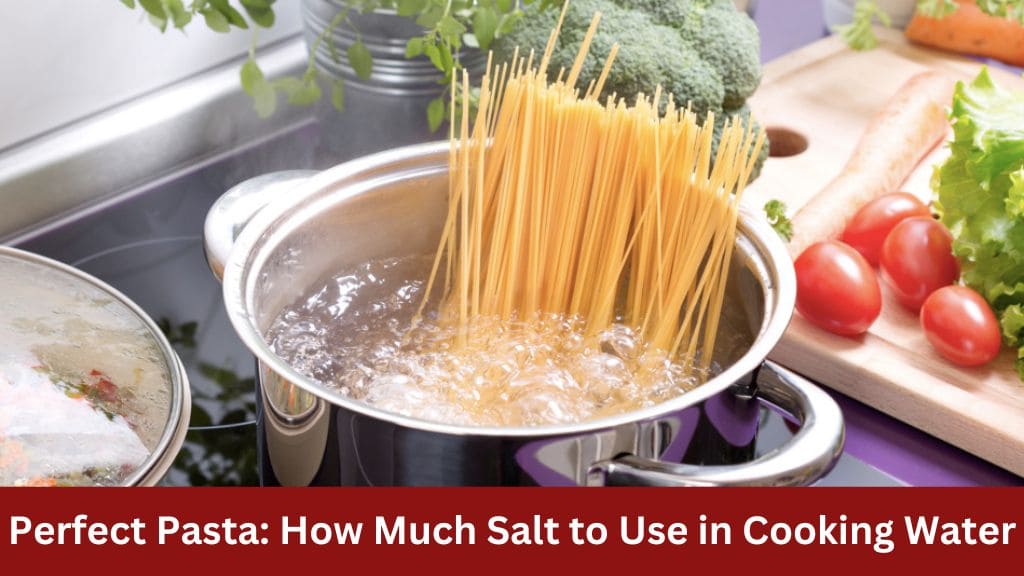Cooking pasta is a staple in many kitchens around the world. Despite its simplicity, there are nuances that can elevate your pasta from ordinary to extraordinary. One critical factor in achieving perfectly seasoned pasta is the amount of salt in the cooking water. This comprehensive guide will walk you through everything you need to know about salting your pasta water.
Why Salt Your Pasta Water?
Flavor Enhancement
Salting pasta water is essential for flavor. When you add salt to boiling water, it dissolves and permeates the pasta as it cooks. This is the only time you can season the pasta itself, ensuring that it has flavor from within, rather than relying solely on the sauce.
Science Behind Salting
Salt increases the boiling point of water, which means it can cook food faster. While the change in boiling point is minimal, the more significant effect is on the texture and flavor absorption. Properly salted water helps pasta absorb the salt, enhancing its natural flavors.
How Much Salt to Use
:max_bytes(150000):strip_icc()/__opt__aboutcom__coeus__resources__content_migration__serious_eats__seriouseats.com__images__2016__02__20160209-amatriciana-pasta-vicky-wasik-011-bf0b7888fa4a4de6b75415eeeef002b0.jpg)
The 1:1:4 Rule
A widely accepted guideline among chefs and home cooks alike is the 1:1:4 ratio, which stands for:
- 1 pound of pasta
- 1 tablespoon of salt
- 4 quarts (16 cups) of water
This ratio provides a solid starting point for ensuring that your pasta is properly seasoned. The idea is to create water that is “salty like the sea,” which is roughly 1-2% salinity.
Understanding Different Types of Salt
Not all salts are created equal. The type of salt you use can affect both the measurement and the final taste of your pasta. Here’s a breakdown:
- Table Salt: This is the most common and finely ground salt, which dissolves quickly in water. It is highly dense and, therefore, the most potent in terms of salinity. For table salt, the 1:1:4 ratio (1 tablespoon per 4 quarts of water) is appropriate.
- Kosher Salt: Kosher salt has larger, coarser grains and is less dense than table salt. Because of its structure, it takes up more volume and is less salty by weight. For kosher salt, you may need to use a bit more to achieve the same level of salinity. Typically, 1.5 tablespoons of kosher salt are used per 4 quarts of water.
- Sea Salt: Sea salt varies greatly in terms of grain size and salinity depending on its origin and how it is processed. Fine sea salt can be used similarly to table salt, while coarse sea salt may require adjustments. Start with the basic ratio and adjust based on your taste preferences and the specific sea salt you are using.
Adjusting for Personal Taste
Everyone’s taste buds are different, and what might be perfectly salted pasta for one person might be too salty or too bland for another. Here’s how you can adjust:
- Start with the Basic Ratio: Begin by following the 1:1:4 rule. Cook your pasta as usual and taste it.
- Incremental Adjustments: If the pasta is not salty enough for your liking, increase the salt by half a tablespoon in your next batch. Conversely, if it’s too salty, reduce the salt by the same amount.
- Keep Track: Make note of the amount of salt used and your satisfaction with the results. This will help you fine-tune the ratio for future cooking.
Consider the Dish as a Whole
When adjusting the salt in your pasta water, also consider the overall saltiness of the final dish. If you are pairing your pasta with a particularly salty sauce (like a puttanesca or a dish with lots of capers and olives), you might want to use slightly less salt in the water. Conversely, for milder, cream-based sauces, a little extra salt in the pasta water can help balance the flavors.
Other Factors to Consider
- Water Volume: Using too little water can result in uneven cooking and overly starchy pasta water. Always use at least 4 quarts of water per pound of pasta. If you’re cooking more pasta or using a larger pot, you might need to increase both the water and the salt proportionally.
- Timing: Add salt to the water once it has reached a rolling boil. This ensures that the salt dissolves quickly and evenly, preventing it from sinking to the bottom and potentially damaging your pot.
Practical Tips
- Taste Test: Don’t be afraid to taste the water before adding the pasta. It should taste salty but not overwhelmingly so.
- Stirring: Stir the pasta occasionally as it cooks, especially in the first few minutes. This helps prevent the pasta from sticking together and ensures even cooking.
Practical Tips for Salting Pasta Water

When to Add Salt
Add the salt to the water once it comes to a rolling boil. This ensures the salt dissolves quickly and evenly. Adding salt before the water boils can pit your pot and slow down the boiling process.
Using the Right Amount of Water
Using too little water can cause the pasta to clump and cook unevenly. Always use at least 4 quarts of water per pound of pasta. More water allows the pasta to move freely and cook uniformly.
Stirring the Pasta
Stir the pasta occasionally as it cooks to prevent sticking and ensure even cooking. This is especially important in the first couple of minutes when the pasta is most likely to stick together.
Benefits of Properly Salted Pasta Water
/cdn.vox-cdn.com/uploads/chorus_image/image/45995224/shutterstock_227043514.0.0.jpg)
Enhanced Taste
Properly salted pasta water results in pasta that tastes better on its own and pairs well with any sauce. It adds a subtle depth of flavor that can’t be achieved by salting the sauce alone.
Improved Texture
Salted water helps maintain the pasta’s texture, ensuring it remains firm and al dente. Unsalted pasta can turn out bland and mushy.
Common Questions and Myths
Can You Over-Salt Pasta Water?
While it’s possible to over-salt pasta water, the recommended ratios make it unlikely. Pasta absorbs only a small fraction of the salt in the water. If your pasta tastes too salty, it’s likely due to adding too much salt or using a saltier variety.
Does Salting Water Really Matter?
Yes, salting water is a crucial step in cooking pasta. Skipping this step will result in bland pasta that relies entirely on the sauce for flavor.
Does the Type of Pasta Matter?
The type of pasta doesn’t significantly impact the amount of salt needed. Whether you’re cooking traditional semolina, whole wheat, or gluten-free pasta, the 1:1:4 ratio is a reliable guideline.
Experimenting with Different Salts
:max_bytes(150000):strip_icc()/Simply-Recipes-No-Cook-Tomato-Sauce-METHOD-06-5b1df73bf7f743659f8af866c496d5e0.jpg)
Table Salt
Fine and easily dissolved, table salt is a common choice. Its strong salinity means you need less of it compared to coarser salts.
Kosher Salt
Preferred by many chefs, kosher salt’s larger crystals make it easier to control and distribute. Its milder taste requires a bit more to achieve the same salinity as table salt.
Sea Salt
Sea salt can add a unique flavor depending on its mineral content and origin. It’s also available in fine and coarse varieties. Start with the standard amount and adjust to taste.
Advanced Tips for Salting Pasta Water
Layering Flavors
For a more nuanced flavor, consider adding herbs or garlic to the boiling water. This infuses the pasta with additional subtle flavors.
Cooking Different Pasta Shapes
While the salting ratio remains the same, different pasta shapes may require slightly different cooking times. Be sure to follow package instructions and taste-test for doneness.
Retaining Pasta Water
Reserve a cup of pasta water before draining. The starchy, salted water can be used to adjust the consistency and seasoning of your sauce.
Conclusion
Salting your pasta water is a simple yet crucial step that can make a significant difference in your pasta dishes. By following the 1:1:4 ratio and adjusting for personal taste, you can ensure that your pasta is perfectly seasoned every time. Experiment with different types of salt and find what works best for you. Happy cooking!





